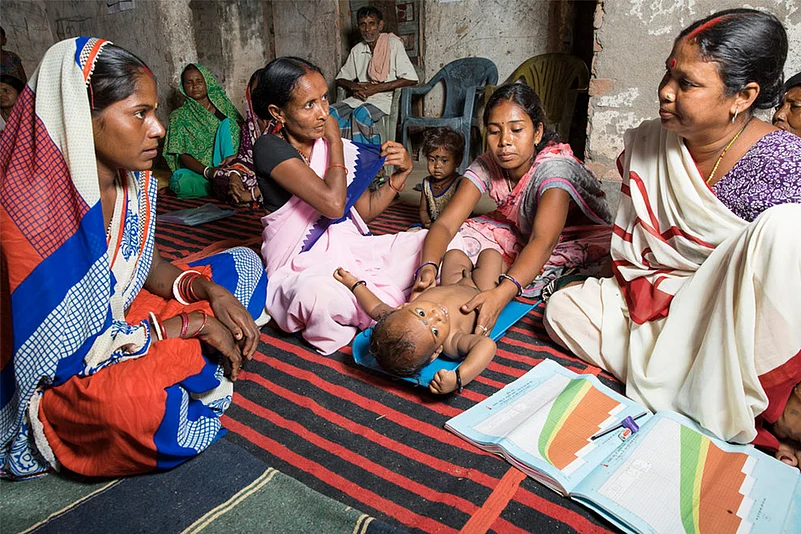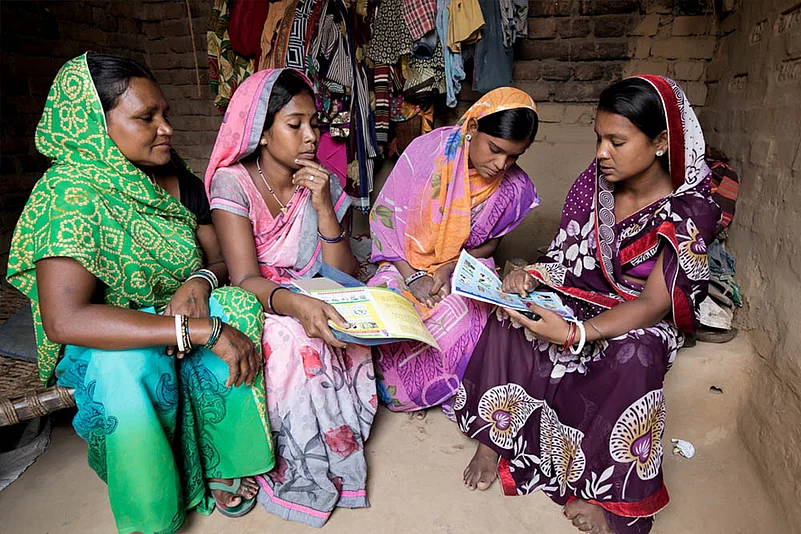A Nutrition Revolution in India must have women in the lead – as small-holder farmers who would ensure she grows the vegetables and fruits needed for her family,? as hamlet-level Janani nutrition warriors who would span across the country in thousands, and also through transforming the women-led Anganwadis into Centres of Excellence and day-long creches.
Only Women -- As Small-Holder Farmers, Janani Nutrition Warriors, Can Help Achieve A Malnutrition-Free India
There is a critical need to invest in women and girls. Adolescent anaemia, poor access to education and skills training, and early marriages deepen the deprivation that women and young girls face.

Our initiatives should be guided by the belief that women play a strategic role in protecting food and nutrition sovereignty and that we will work to empower women with research-backed information, tools and methods to bring changes in their human conditions and social positions. ?Women small-holder farmer-led evergreen revolution for climate-smart and nutrition-sensitive agriculture will be key to success.
The right to food and nutrition during the first 1,000-days and prior to that has a profound impact on a child’s ability to grow, learn and thrive — and a lasting effect on a country’s health and prosperity. There is a critical need to invest in women and girls. Adolescent anaemia, poor access to education and skills training, and early marriages deepen the deprivation that women and young girls face.

In India, 26.8 per cent women marry before the age of 18, and at least 28.8 per cent married women face domestic violence. This has implications on women’s mental health and highlights their poor decision rights and control over resources. The patriarchal system and its overarching impact on women is the single largest obstacle to attaining food and nutrition equity in the country.
There is an urgent need to address the power systems at work at the social, filial and personal level.?
We need to work on climate-smart and nutrition-sensitive agriculture, nutrition for industrial workers and their children, and on Social Behaviour Change Communication areas with a focus on inter-personal counselling to generate demand for nutrition and change behaviour.
Food and nutrition should be treated as public good; that is provided without profit to all members of society, either by the government or by a private individual or organization and prioritizes actions on hunger and malnutrition hotspots.
?Converge to transform – Anganwadis as Centres of Excellence
?The Anganwadi Centre should emerge as a Centre of Excellence on convergence at the village level. Similar convergence can happen at the sector, block, district, state and national level. Along with the convergence at the system level, there is a need for convergence and synergy with multiple platforms, actors, leaders and stakeholders. For maximum outcome and building a people’s movement, the nutrition programme needs to leverage resources, technologies and learnings from a number of other flagship programmes. Other platforms like India’s Self Help Group (SHG), dairy cooperatives, local governments, schools and colleges can be mobilized for this Sustainable Nutrition Revolution.

Strategic Initiatives
The strategic initiatives at different levels could be as follows:
1. People - 2.5 million hamlet-level JANANIs (Join Angan Nutrition Awareness for New India), women change leaders to lead at forefront:
We need a people’s movement to make good nutrition an element in life cycle approach – that highlights the need to target nutrition programmes to key moments in a person’s life. There has to be a convergence among the relevant departments, platforms, leaders, local government, cadres, staff and volunteers to build an enabling environment to ensure synergistic action and contribute to the ambitious agenda of Mission Malnutrition Free India.??

I envisage 2.5 million hamlet level JANANIs (Join Angan Nutrition Awareness for New India); women change leaders in 6,49,481 villages of India who act as promoters and monitors of good nutrition and health practices in the neighbourhood (one Janani for 15-20 families). They would also counsel families on a voluntary basis to induce and promote positive health nutrition and sanitation behaviour. JANANIs as nutrition warriors would serve as a link between service providers and the community.?
Women small holder farmers, elected women representatives at the local government level, women self-help group members and grassroot women functionaries can amplify the people’s movement along with JANANIs.
2. Product- Culture and context -specific safe and nutritious foods:
India has numerous exemplary states which have shown the way how using home-grown and home-made safe and nutritious foods has seen substantial reduction in anaemia, stunting and wasting. At the same time, rising obesity and overweight levels indicate a fragmented food system.
In the absence of proper awareness, inability to afford right foods and absence of regulatory enforcement and monitoring mechanism, the poor and vulnerable access unsafe and sometimes, poor quality food. India needs to address the broken food system and promote culture and context -specific safe and nutritious foods.
Advertisement
In this context, a National Micronutrient Status Survey would be helpful to target and promote food enrichment programmes such as supplementation, fortification, including bio-fortification programme, to address micronutrient malnutrition and morbidity through proper quality assurance and quality control measures and regulatory enforcement.
The food systems approach can address malnutrition by improving the food value chain, integrating livelihoods and other food entitlement programmes like Public Distribution System (PDS), Integrated Child Development Scheme (ICDS) and Mid-Day Meal (MDM).?
3. Policy- ?A new legislation on food and nutrition to include food and nutrition in a life cycle approach:
Pregnancy through infancy (also known as the first 1,000 days) is the most critical period of growth and development in a child’s life. Nutritional gains during this period continue to benefit the child throughout life, while the damage from nutritional losses lasts a lifetime.?Since 1975, India has demonstrated a number of policy level measures to address food and nutrition security. However, it needs a structural reform and breakthrough policy level changes to address perpetual poverty and malnutrition.
Advertisement

The present National Food Security Act -2013 is grossly inadequate to address sustainable food and nutrition security in the country. India needs a new national legislation on Food and Nutrition Security to deal with, a) farmer’s security, b) sustainable food and nutrition security, c) food safety including management of food and nutrition value chain, and d) preserving bio safety and bio diversity.
Similarly, India also needs good governance and good policy on dry land agriculture and alternative medicine, MNREGA to support kitchen gardens, bio-fortified crop and dryland agriculture, conversion of Anganwadi centers into daylong crèches, Special Budget for Agriculture, Food Security and Nutrition, and CSR on nutrition, increase in MSPs for coarse grains that is twice the procurement price of rice, and a comprehensive legislation on food fortification.? A special Ministry on Food Security and Nutrition and National Food and Nutrition Commission will be a pragmatic step.
Advertisement
A policy breakthrough in revolutionizing dry land agriculture, promotion of horticulture to increase dietary diversity, promotion of bio fortified crops like moringa, a Minimum Support Price (MSP) for millets that is twice the procurement price of rice, establishing a Bio-Fortification Mission and Bio-Safety Authority, a Centre for Excellence on Sickle Cell Anaemia and Anaemia Management are the need of the hour.?
4. Platforms and Partnerships- for message and stakeholder alignment: It is all about fighting malnutrition together, convene and converge to trigger transformative action.
In the nutrition sector, the greatest challenge is message and stakeholder alignment. It has to be resolved. The sector needs better inter and intra -departmental convergence and more and more people’s networks, strategic alliances and coalitions.? These platforms in public space can converge and optimize efforts for better programme outcomes.? The village level platform like VHNSD - village health nutrition sanitation day - needs to function excellently with support from the community, local government, health and ICDS (Integrated Child Development Services) department.? Anganwadi Centres can be a Centre of excellence with convergence of all other services.
Advertisement
5.Programme - to encompass both nutrition-focused and nutrition-sensitive interventions in a responsible way:?
The nutrition-focused interventions like breastfeeding, complementary feeding, treating the severely affected malnourished children, care during pregnancy, delayed cord clamping, full immunization and bi-annual vitamin A supplementation with deworming, diarrhoea management with oral rehydration solution and zinc supplementation, Vitamin K administration (appropriate dosage) to all new-born children, special programme for adolescent girls to combine with nutrition-sensitive interventions like equitable? access to food (including dietary diversity), primary health care, safe drinking water, and environment and address gender issues pertaining to low sex ratio, women’s empowerment, access to education, delayed age at marriage and age of first conception, and birth spacing etc. for a sustained result.
Advertisement

Early and exclusive breastfeeding and breastfeeding with appropriate complementary feeding for the children, addressing calorie inadequacy , widening the food basket, dietary diversity to address calorie inadequacy, addressing protein hunger through improving/diversifying both production and farming system to include poultry, fishery production etc., climate smart agriculture and farming system and addressing micronutrient malnutrition through food enrichment can be programmatic interventions.
There has to be a special programme to address anaemia in all forms and severely affected malnourished children in hunger and malnutrition hotspots. Naturally bio-fortified crops like drumstick, sweet potato, minor millets, amla etc. need to be promoted. We need to stop nutrition disruptions and address the social, geographical, policy level and economic exclusions.
Advertisement
Planet health is necessary for human health. We need to empower the people specifically women to take control over health and nutrition issues for a sustainable nutrition revolution India needs today.
(This is the?FIfth ?in a series of articles on the need for a Nutrition Revolution in India.? Basanta Kumar Kar, a native from Odisha, is recipient of the prestigious global ‘Transform Nutrition Champions’’ award for outstanding contribution to nutrition in South Asia and the ‘Odisha Living Legend’ award for contribution to public policy. For his decades long contribution to champion the cause of sustainable food and nutrition security in India and globally, Kar is also known as the ‘Nutrition Man’.? He? is?currently Country Director,? Project Concern International/India, Contact-?[email protected])??
Advertisement
-
Previous Story
 'Anti-Constitutional, Against Law': Siddaramaiah On Karnataka Governor's Prosecution Sanction Against Him
'Anti-Constitutional, Against Law': Siddaramaiah On Karnataka Governor's Prosecution Sanction Against Him - Next Story


















